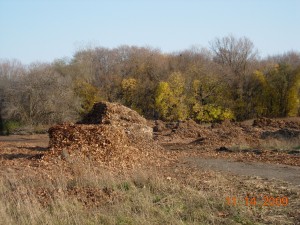
Large, old bur oak, one of many at Colony Farm Orchard. Photo by Richard Brewer
The major story in the Western Herald today, on the front page above the fold, is “SSE advocates Orchard property preservation.” The story was written by Fritz Klug, News Editor of the Herald.
SSE is the student organization Students for a Sustainable Earth. SSE describes itself as the premiere organization for student environmentalists at WMU. It’s a registered student organization whose mission is to promote attitudes and behaviors on the WMU campus and in the wider Kalamazoo community that are environmentally and culturally sustainable. It has a Facebook group of 435 members.
The story begins with a field trip that a mostly student group of 26 persons, took to the Colony Farm Orchard in October. SSE hosted it as a part of their campaign to save the Enchanted Forest. Benjamin Thayer, a WMU senior is quoted as saying, “It is enchanted because it’s a place in limbo.” This is an excellent, remarkably apt characterization. My dictionary defines limbo as a region of oblivion or neglect. WMU has neglected the Colony Farm Orchard, perhaps so that the claim could be made that the property is not utilized. And certainly, if WMU’s plans for the land are allowed to proceed, oblivion is its fate.
In the story, SSE Co-Chair Andrew Weissenborn indicates no opposition to the current BTR Park or the aim of job creation. “It is neat and extraordinary what WMU has done with the first BTR park,” he is quoted as saying, “but I do not think the park should be extended to the Colony Farm Orchard. The focus at this point is to preserve the land.”
The other front page story of the Herald, below the fold, is “WMU researchers study carbon sequestration benefits.” It describes research proposed by a Geosciences group to study sequestering carbon dioxide from large facilities such as factories and power plants by storing it at depths of 2500-3000 feet in porous sedimentary rocks where overlain by impermeable igneous rocks. It’s a possible technology that, along with many other techniques including conservation and alternative energy sources, may help us out of the global climate aspect of our current environmental predicament.
In the meantime, the Colony Farm Orchard continues sequestering carbon in its humble way–in the growth of old trees planted or self-seeded long ago and the many young ones that have volunteered in the past 50 years, in the vines of old grapes from the abandoned arbors as well as native grape-vines from seeds brought in by catbirds and robins, and in the large amounts of soil organic matter that accumulates each year mostly from foliage. Even a fair share of the carbon in the tree leaves from the west side of Kalamazoo that WMU allows the city to dump at the Orchard site becomes incorporated in rather long-lived compounds in the soil, making its own sequestration contribution.

Leaves from trees in the city of Kalamazoo dumped at Colony Farm Orchard